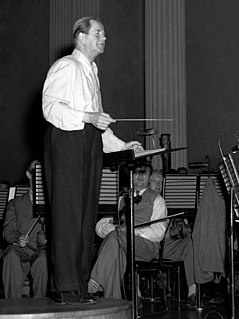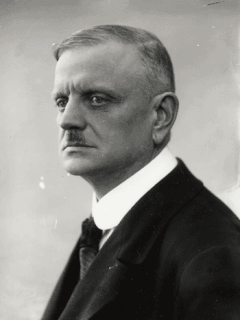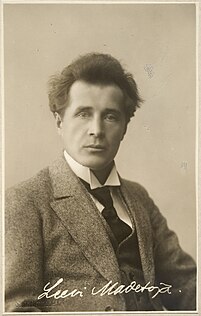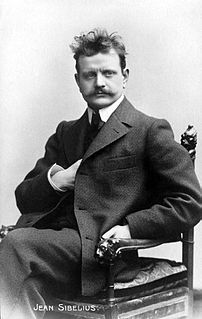
A string orchestra is an orchestra consisting solely of a string section made up of the bowed strings used in Western Classical music. The instruments of such an orchestra are most often the following: the violin, which is divided into first and second violin players, the viola, the cello, and usually, but not always, the double bass.

Esa-Pekka Salonen is a Finnish orchestral conductor and composer. He is principal conductor and artistic advisor of the Philharmonia Orchestra in London, conductor laureate of the Los Angeles Philharmonic, and music director of the San Francisco Symphony.

Uuno (Kalervo) Klami was a Finnish composer of the modern period. He is widely recognized as one of the most significant Finnish composers to emerge from the generation that followed Jean Sibelius.

Karelia Suite, Op. 11 is a subset of pieces from the longer Karelia Music written by Jean Sibelius in 1893 for the Viipuri Students' Association and premiered, with Sibelius conducting, at the Imperial Alexander University in Helsinki, Grand Duchy of Finland, on 23 November of that year. Sibelius first conducted the shorter Suite ten days later; it remains one of his most popular works.

Tauno Heikki Hannikainen was a Finnish cellist and conductor.
Saint-Saëns' Cello Concerto No. 2 in D minor, Op. 119, is written in two movements, like his Fourth Piano Concerto. It was composed in 1902 and is dedicated to the Dutch cellist, Joseph Hollman, who gave the first performance on February 5, 1905 in Paris. The Second Concerto is much more virtuosic than the First, but does not possess the thematic inventiveness and harmonic intricacy of the First.
Olli Mustonen is a Finnish pianist, conductor, and composer.
The International Uuno Klami Composition Competition is a composition competition. It has been held once in five years since 2004 and it has been named after the Finnish composer Uuno Klami. It is being organized by Kansainvälisen Uuno Klami –sävellyskilpailun kannatusyhdistys ry, which consists of Kymi Sinfonietta and the cities of Kotka and Kouvola, Finland. Kymi Sinfonietta also plays the works in the finals. The main goal of the competition is to bring forward the life work of Uuno Klami and to help improve his international recognition. Moreover, the mission of the competition is to produce new repertoire for sinfonietta-sized orchestras.

Sebastian Fagerlund is a Finnish composer. He is described as “a post-modern impressionist whose sound landscapes can be heard as ecstatic nature images which, however, are always inner images, landscapes of the mind”. Echoes of Western culture, Asian musical traditions, and heavy metal have all been detected in his music.
Sauli Zinovjev is a Finnish composer. Zinovjev was born in Lahti, and studied composition in Sibelius Academy (2010–15) and in HfM-Karlsruhe (2013–14) under guidance of Tapio Nevanlinna and prof. Wolfgang Rihm. Zinovjev's works are published exclusively by HarrisonParrott's Birdsong Music Publishing.

My Own Land, Op. 92, is a single-movement cantata for mixed choir and orchestra written in 1918 by the Finnish composer Jean Sibelius. The piece, which is a setting of Kallio's Finnish language poem of the same name, is the first in a series of four "little known but beautiful", patriotic cantatas from the composer's mature period—including Song of the Earth ; Hymn of the Earth ; and Väinämöinen’s Song. My Own Land premiered on 25 October 1918 in Helsinki with Armas Maasalo conducting the Helsinki Youth League —the commissioning ensemble and dedicatee—and the Helsinki Philharmonic Orchestra.

The Symphony No. 1 in F major, Op. 29, is a three-movement orchestral composition by the Finnish composer Leevi Madetoja, who wrote the piece from 1914–16 at the dawn of his professional career. Although late-Romantic in style, the symphony carefully eschews the extravagance and overindulgence typical of debut efforts, placing it among the most "mature" and restrained of first symphonies. Accordingly, the First is the shortest and most concentrated of Madetoja's three essays in the form and is the only one of his symphonies not to adhere to the traditional four-movement symphonic template.

Elegia, Op. 4/1, is a composition for string orchestra by the Finnish composer Leevi Madetoja, who wrote the piece in 1909 during his student years. On 10 January 1910, Robert Kajanus, chief conductor of the Helsinki Orchestral Society, premiered the Elegia to great acclaim, with the piece described as the "first master work" of a budding "natural orchestral composer". Madetoja subsequently designated the Elegia as the first number in his four-movement Sinfoninen sarja, Op. 4, which the Helsinki Orchestral Society performed in its entirety under the composer's baton on 26 September 1910. The suite's three other numbers are virtually unknown, and the Elegia typically is performed as a stand-alone concert piece. Stylistically reminiscent of Tchaikovsky, it is, to date, Madetoja's most recorded and well-known orchestral composition, as well as the most enduringly popular of his many miniatures.
The Symphony No. 1, Op. 24, is an orchestral composition by the Finnish composer Aulis Sallinen, who began writing the piece in 1970 when the City of Helsinki announced a composers' competition to mark the inauguration of Finlandia Hall. Completing the symphony in 1971, Sallinen was awarded First Prize in the contest; the Helsinki Philharmonic Orchestra and its music director, Jorma Panula, premiered the work at Finlandia Hall during the 2 December inaugural festivities.
The Symphony No. 4, Op. 49, is an orchestral composition by the Finnish composer Aulis Sallinen, who wrote the piece from 1978–79 for a commission from the City of Turku, to celebrate its 750th anniversary. The Turku Philharmonic Orchestra premiered the work on 9 August 1979, under the direction of its principal conductor, Pertti Pekkanen.

The Finnish composer Jean Sibelius (1865–1957) was one of the most important symphonists of the early twentieth century: his seven symphonies, written between 1899 and 1924, are the core of his oeuvre and stalwarts of the standard concert repertoire. Many of classical music's conductor–orchestra partnerships have recorded the complete set, colloquially known as the "Sibelius cycle". Specifically, the standard cycle includes:

The Symphony No. 1 is a four-movement orchestral composition by the Finnish composer Uuno Klami, who wrote the piece from 1937 to 1938. Georg Schnéevoigt and the Helsinki Philharmonic Orchestra premiered the work on 5 May 1939; later that year, Klami enlisted in the Finnish military and fought against the Soviet Union in the Winter War.

The Symphony No. 2 is a four-movement orchestral composition by the Finnish composer Uuno Klami, who wrote the piece from in 1945; it is the final of Klami's two numbered symphonies. Toivo Haapanen and the Helsinki Philharmonic Orchestra premiered the work at the Helsinki Conservatory on 15 December 1946.

Suomenlinna, Op. 30, is concert overture for orchestra written between 1939 and 1940 by the Finnish composer Uuno Klami, who had visited the eponymous island sea fortress. Tor Mann and the Swedish Radio Symphony Orchestra premiered the work in Stockholm on 21 May 1941. The overture is in sonata form, with its main theme in C major and second theme in D-flat major.











